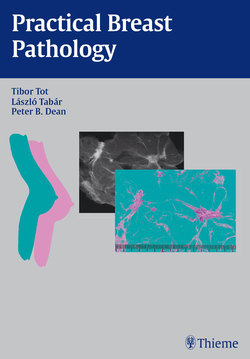Читать книгу Practical Breast Pathology - Tibor Tot - Страница 8
На сайте Литреса книга снята с продажи.
ОглавлениеChapter 2
General Morphology of Breast Lesions
Most pathologic processes in the breast originate in the terminal ductal-lobular units (TDLUs). The affected TDLUs are distended, distorted, or destroyed by the accumulation of fluid, mucin, cancer cells, necrotic debris, or calcium in the lumina of the acini and of the terminal duct or by the accumulation of collagen, glycoproteins, or stromal cells in the intralobular stroma (Fig. 2.1, thick-section image).
Fig. 2.1
If the pathologic process primarily distends and distorts the TDLU, spherical or oval lesions develop (Fig. 2.2, thick-section image).
Fig. 2.2
If the pathologic process destroys and replaces the pre-existent TDLU, a stellate lesion may develop (Fig. 2.3, thick-section image).
Fig. 2.3
All pathologic processes lead to a considerable enlargement of the TDLU. In neoplasia, the largest diameter of the largest invasive lesion is considered to be the tumor size.
As a result of distension or destruction, or both, most breast tumors are round/oval (Fig. 2.4) or stellate (Fig. 2.5).
Fig. 2.4
Fig. 2.5
By coalescence of the distended, distorted, and destroyed structures and invasion of the tumor into the interlobular stroma, the shape of the lesion may become increasingly complex (Fig. 2.6).
Fig. 2.6
Fig. 2.7
Fig. 2.8
Fig. 2.9
Fig. 2.10
Fig. 2.11
Fig. 2.12
The spherical/oval shape is not tumor-specific and can be seen in different pathologic processes, such as: cysts (Figs. 2.7 and 2.8) and fibroadenomas; medullary (Fig. 2.7), mucinous (Fig. 2.4), and ductal carcinomas (Fig. 2.9); metastases in the breast (Fig. 2.10); and malignant mesenchymal tumors (Figs. 2.11 and 2.12).
On the other hand, stellate lesions are usually carcinomatous, but may seldom be radial scars or fibrous scars (Fig. 2.13, thick-section image).
Fig. 2.13
Fig. 2.14
If the pathologic process involves only one TDLU or a few neighboring TDLUs, a unifocal lesion develops (Fig. 2.14).
Fig. 2.15
If the pathologic process simultaneously involves more than one distant TDLU leaving uninvolved TDLUs in between, the lesions are considered to be multiple (multi-focal) (Fig. 2.15).
Fig. 2.16
When there is simultaneous involvement of a large number of TDLUs, the lesion may exhibit a diffuse growth pattern (Fig. 2.16).
Thus, lesions in the breast may have one of the following three distributions: solitary (unifocal), multiple (multifocal) and diffuse.
If more than one TDLU is involved, all may exhibit the same pathologic process, but often different processes are present at the same time: in situ and invasive lesions coexist, different tumor types may be present, and the tumor grade may vary considerably within same specimen. The resulting complex histologic picture is an expression of intratumoral heterogeneity (Figs. 2.17 and 2.18). Intratumoral heterogeneity may develop even in a unifocal tumor when different tumor cell clones evolve during tumor progression and dedifferentiation.
Intratumoral heterogeneity may also make the measurement of the tumor size insufficient to represent the whole lesion. The entire area of the present invasive and in situ foci has to be assessed. This parameter is referred to as the extent of the disease.
Fig. 2.17
Fig. 2.18
The location of the lesions can be objectively determined by a combination of clinical, mammographic, and ultrasound parameters. To achieve uniform terminology, a horizontal plane and a vertical plane going through the nipple divide the breast into four quadrants: the upper lateral, upper medial, lower medial, and lower lateral. In addition, a fifth area of the central, retroareolar cylinder is defined (Fig. 2.19). By applying different orthogonal projections when imaging the breast, the radiologist can measure the distance between the lesion and the nipple. Since the location of the lesion within the breast cannot be determined solely from a histologic section, a system of marking the operative specimen is needed to provide orientation.
Fig. 2.19
Fig. 2.20
Mammography and ultrasound examinations provide a good overview of the entire breast. The size, extent (the involved area), distribution (unifocal, multifocal, or diffuse), and location of the lesions are usually well seen. Even when the lesions are not seen directly on the mammogram but are detected by indirect signs-such as microcalcifications-the size, extent, distribution, and location of the lesions can still be well marked. The size, extent, and distribution of the lesions are well seen on the specimen radiograph postoperatively (Figs. 2.20 and 2.21).
Histologic examination of the specimen is always necessary to further characterize the pathologic process after its size, extent, and distribution have already been indicated by the mammogram. Histologic examination should prove or rule out malignancy, delineate the in situ and the invasive components, grade and type the tumors, reveal intratumoral heterogeneity if present, and provide further morphologic-prognostic factors needed for therapy. Usually, and especially in cases of “indirect mammographic signs,” the more sensitive method of histology reveals more details than the mammogram itself.
Fig. 2.21
Conclusions
For a successful collaboration within the breast team, radiologists, surgeons, oncologists, and pathologists must each understand the terminology used by the other members of the team. Assessment of the size, distribution, extent, and location of the lesions preoperatively and postoperatively using the mammographic-pathologic correlative approach is a prerequisite for successful collaboration. These parameters are not only important diagnostic and prognostic features; they also represent the basis for proper planning of surgical interventions and oncologic therapy.
